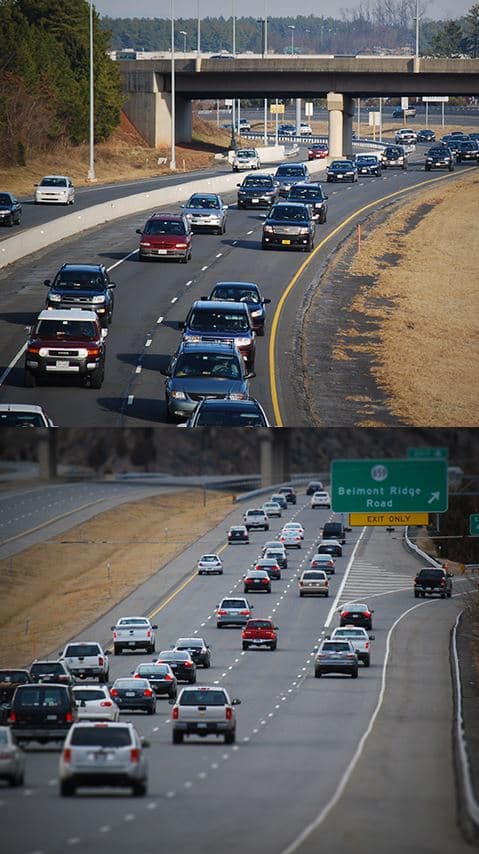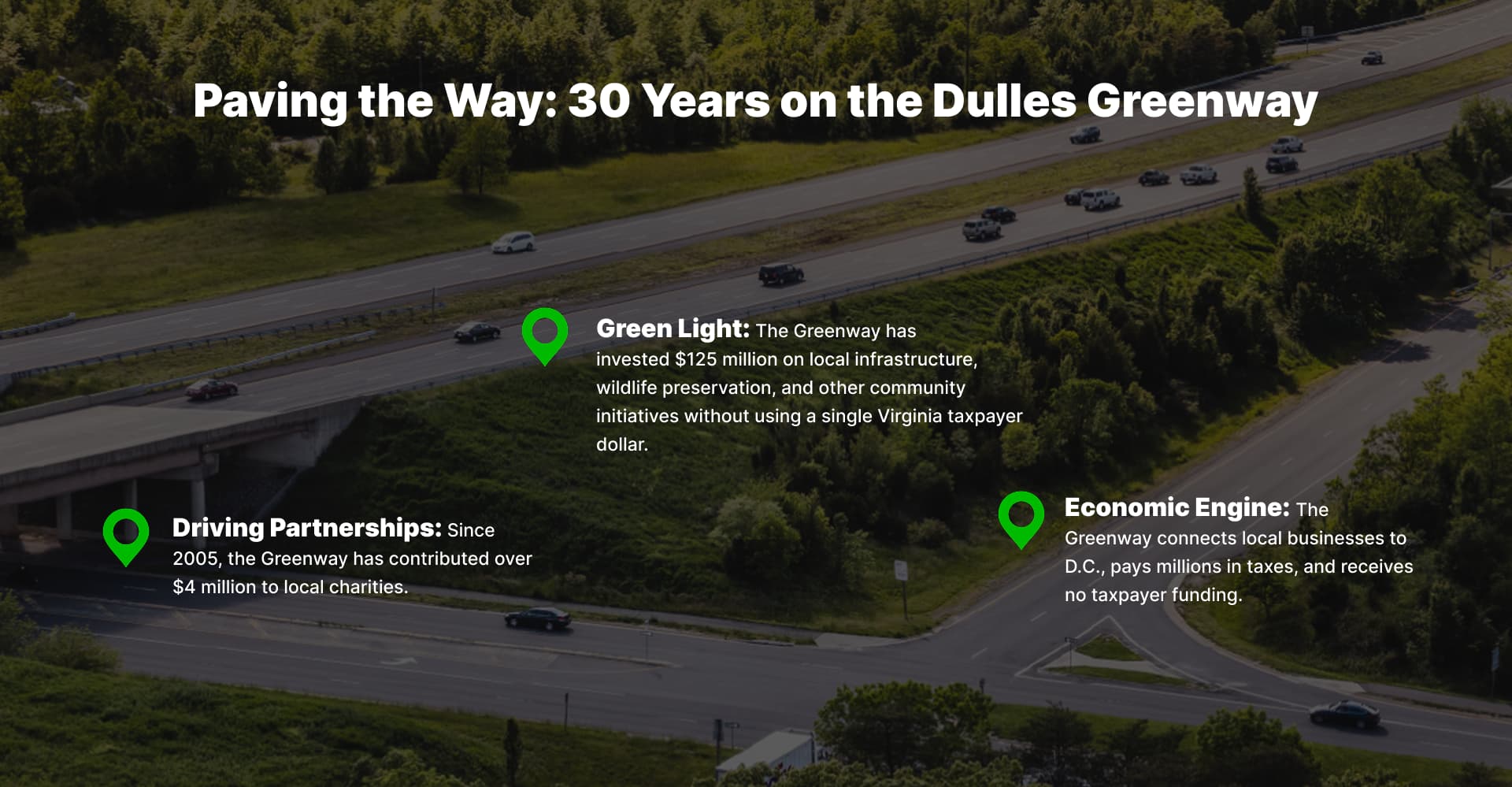About the Greenway
Take a closer look at the Greenway. A history of infrastructure development and community investment.
The Greenway is committed to being a Good Partner to the community, environment, and the Commonwealth.
In the News
30 Years Ago
When the Greenway opened its lanes 30 years ago, a toll road was a bit of a novelty. In fact, it was the first private toll road in Virginia since 1816. People thought roads should be free. But soon enough privatization of roads became more common around the world and in the United States. Mrs. Maggie Bryant, of Middleburg, Virginia was the driving force behind the construction of the Dulles Greenway – with the foresight that the road could stimulate economic development in Loudoun County while preserving its natural environment and beauty. Mrs. Bryant, along with other partners, secured conventional financing to purchase the land at market value and then construct, maintain, and operate the Dulles Greenway.
Today
The Dulles Greenway provides a faster trip for the average Northern Virginia commute, with traffic moving at 65 miles an hour and saving commuters an hour and 20 minutes over the course of a week at peak travel times. The Dulles Greenway offers a consistent and middle of the price range transportation option when evaluating price per mile, which is important given the high costs for transportation in the DMV region.

Quick Facts
65 mph
The average NOVA commuter, can only go 20 mph. The Greenway moves commuters at 65 mph, saving an hour and 20 minutes over the course of a week at peak travel times.
Safer Commute
Safety is paramount at The Greenway because one injury is too many. We have only 7.2 injury-inducing accidents per 100 million vehicle miles compared to about 80 accidents on surrounding Loudoun County roads.
149 Acres
The Greenway is committed to the local community. We support local businesses and preserve the environment. Local wetlands have been doubled by the Greenway to 149 acres.
$125 Million
The Greenway has invested $125 million over 25 years on local infrastructure, wildlife preservation, and other community initiatives without using a single Virginia taxpayer dollar.
$4 Million
The Greenway has contributed more than $4 million and counting to Loudoun County charities that support people in the community and the local environment.
VIP Status
Members of the VIP Miles Frequent Rider Program collectively earned $209,976 in cash back savings in 2024. It is our way of thanking you for choosing Dulles Greenway.
FAQ
Find the answers to our frequently asked questions here.
- What if I back out of the Toll Collection Lane?
Your E-ZPass transponder is identified upon entering the lane approximately 60 feet prior to the toll booth. Once your E-ZPass has been identified you have committed to completing the transaction in that lane. If the car in front of you is delayed in the lane and you decide to back out of the lane, your transponder will not work in the next lane because it was already identified and assigned to the original lane. Thus, you will be stuck in the new lane, causing another bottleneck and very likely causing another vehicle to back-up.
- What if I fail to mount the E-ZPass properly to vehicle windshield?
The E-ZPass transponder is designed to be mounted on the windshield of your vehicle to ensure that the device is at the proper angle and positioned to communicate with the E-ZPass antenna. Holding the device in your hand impedes the radio signal as well as changes the required angle and position and more than likely will cause the E-ZPass to fail.
- Why doesn't the Dulles Greenway offer variable toll pricing based on usage?
The Dulles Greenway’s current layout cannot accommodate distance-based pricing. The Greenway was designed to maximize the efficiency of the toll collection process…thus expediting traffic flow. This design–much like that of the Dulles Toll Road–does not offer a discount for partial usage.
- Why doesn't your remote toll booths accept coins?
The Greenway elected not to use coin-operated toll machines for several reasons. First, processing time for coin transactions can actually be longer than the time needed for credit card transactions. Also, coin machines require much higher maintenance, due to vandalism, foreign objects, and coin jams. However, most importantly, coin machines pose a security risk to Greenway employees who transfer funds between locations. We feel that credit card and E-ZPass transactions are the safest, most expedient methods for unmanned toll collection.
- What if I have two E-ZPass Transponders in my vehicle?
Although your old transponder is no longer assigned to your account it will be identified in the toll lane as long as it remains in your vehicle. The old transponder that is now in the glove compartment, middle console, under the seat or in the trunk is being identified by the toll collection system as an invalid E-ZPass. This additional transponder in your vehicle will not only cause problems with the toll collection system but can also lead to your vehicle being identified as a toll violator. To ensure that your E-ZPass works as designed and the toll lanes remain free flowing please remove all other E-ZPass transponders from your vehicle.
- Does the Dulles Greenway accept cash?
No, motorists are not able to pay cash on the Dulles Greenway for their toll. The Dulles Greenway does accept credit card types as well as E-ZPass.
Your E-ZPass transponder is identified upon entering the lane approximately 60 feet prior to the toll booth. Once your E-ZPass has been identified you have committed to completing the transaction in that lane. If the car in front of you is delayed in the lane and you decide to back out of the lane, your transponder will not work in the next lane because it was already identified and assigned to the original lane. Thus, you will be stuck in the new lane, causing another bottleneck and very likely causing another vehicle to back-up.
The E-ZPass transponder is designed to be mounted on the windshield of your vehicle to ensure that the device is at the proper angle and positioned to communicate with the E-ZPass antenna. Holding the device in your hand impedes the radio signal as well as changes the required angle and position and more than likely will cause the E-ZPass to fail.
The Dulles Greenway’s current layout cannot accommodate distance-based pricing. The Greenway was designed to maximize the efficiency of the toll collection process…thus expediting traffic flow. This design–much like that of the Dulles Toll Road–does not offer a discount for partial usage.
The Greenway elected not to use coin-operated toll machines for several reasons. First, processing time for coin transactions can actually be longer than the time needed for credit card transactions. Also, coin machines require much higher maintenance, due to vandalism, foreign objects, and coin jams. However, most importantly, coin machines pose a security risk to Greenway employees who transfer funds between locations. We feel that credit card and E-ZPass transactions are the safest, most expedient methods for unmanned toll collection.
Although your old transponder is no longer assigned to your account it will be identified in the toll lane as long as it remains in your vehicle. The old transponder that is now in the glove compartment, middle console, under the seat or in the trunk is being identified by the toll collection system as an invalid E-ZPass. This additional transponder in your vehicle will not only cause problems with the toll collection system but can also lead to your vehicle being identified as a toll violator. To ensure that your E-ZPass works as designed and the toll lanes remain free flowing please remove all other E-ZPass transponders from your vehicle.
No, motorists are not able to pay cash on the Dulles Greenway for their toll. The Dulles Greenway does accept credit card types as well as E-ZPass.
 Download Infographic
Download Infographic

